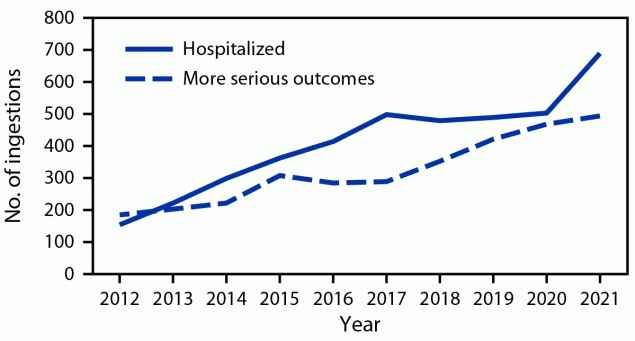Erratum: Vol. 71, No. 22
Weekly / July 8, 2022 / 71(27);885
In the report, “Pediatric Melatonin Ingestions — United States, 2012–2021,” on page 726 in the first full paragraph, the third sentence should have read, “Most children (84.4%) were asymptomatic.”
On page 727, the Table contained multiple errors: rows 18 and 19 (with the headings “Asymptomatic” and “Symptomatic”) should have been deleted, the final original footnote should have read, “Cases confirmed as nonexposures and exposures deemed not responsible for the effect,” two additional footnotes should have been included, and all footnotes should have been reordered. In addition, the abbreviation “RCF = relative contribution to fatality” should have been included. The Table has been updated accordingly.
On page 727, in Figure 2, the y-axis was incorrectly formatted to demonstrate stacked values. Figure 2 has been updated accordingly.
Abbreviations: CNS = central nervous system; HCF = health care facility; ICU = intensive care unit; RCF = relative contribution to fatality.
* Number of clinical effects (n = 45,647) is greater than the number of symptomatic ingestions (n = 40,665), as some children had more than one symptom.
† No signs or symptoms.
§ Minimally bothersome symptoms, self-limited, and resolved without intervention (e.g., self-limited gastrointestinal symptoms).
¶ More serious outcomes included moderate effect (systemic symptoms requiring intervention; not life-threatening [e.g., brief seizure readily resolved with treatment, or high fever]), major effect (life-threatening symptoms [e.g., status epilepticus or respiratory failure requiring intubation]), and death.
** RCF: Unknown. A case is classified as RCF “unknown” in the National Poison Data System if the Clinical Case Evidence is not sufficient to rule in or rule out the exposure as the cause of death.
†† Cases confirmed as nonexposures and exposures deemed not responsible for the effect.
 FIGURE 2. Number of pediatric* melatonin ingestions reported† to poison control centers, by outcome and year — United States, 2012–2021
FIGURE 2. Number of pediatric* melatonin ingestions reported† to poison control centers, by outcome and year — United States, 2012–2021

* Aged ≤19 years.
† More serious outcomes include moderate or major effect or death, as defined by the National Poison Data System Coding Manual. Disposition (including hospitalization) and medical outcome (including more serious outcomes) are not mutually exclusive because persons with more serious outcomes are likely to be hospitalized.
Suggested citation for this article: Erratum: Vol. 71, No. 22. MMWR Morb Mortal Wkly Rep 2022;71:885. DOI: http://dx.doi.org/10.15585/mmwr.mm7127a4.
MMWR and Morbidity and Mortality Weekly Report are service marks of the U.S. Department of Health and Human Services.
Use of trade names and commercial sources is for identification only and does not imply endorsement by the U.S. Department of
Health and Human Services.
References to non-CDC sites on the Internet are
provided as a service to MMWR readers and do not constitute or imply
endorsement of these organizations or their programs by CDC or the U.S.
Department of Health and Human Services. CDC is not responsible for the content
of pages found at these sites. URL addresses listed in MMWR were current as of
the date of publication.
All HTML versions of MMWR articles are generated from final proofs through an automated process. This conversion might result in character translation or format errors in the HTML version. Users are referred to the electronic PDF version (https://www.cdc.gov/mmwr) and/or the original MMWR paper copy for printable versions of official text, figures, and tables.
Questions or messages regarding errors in formatting should be addressed to mmwrq@cdc.gov.